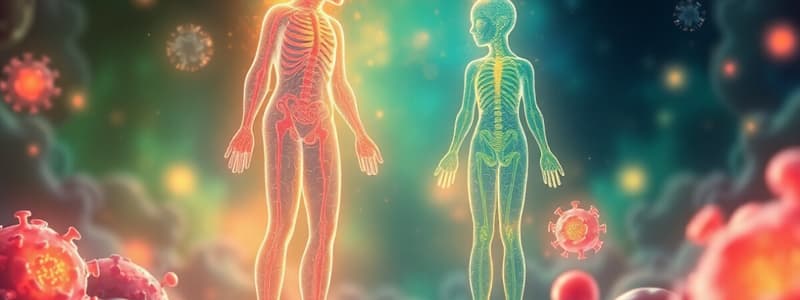Podcast
Questions and Answers
What is a characteristic feature of innate immunity?
What is a characteristic feature of innate immunity?
- Immediate action against pathogens (correct)
- Production of specific antibodies
- Memory response upon re-exposure
- Development over time
Which of the following conditions is an example of a primary immunodeficiency?
Which of the following conditions is an example of a primary immunodeficiency?
- HIV/AIDS
- Immunosuppressive therapy
- Splenectomy
- Chronic Granulomatous Disease (correct)
Which of the following is NOT a common pathogen and its associated infection?
Which of the following is NOT a common pathogen and its associated infection?
- Trichomonas vaginalis - vaginitis
- Cryptococcus neoformans - skin infection (correct)
- Trichomonas vaginalis - protozoan infection
- Plasmodium - malaria
Which of the following components is part of the adaptive immunity?
Which of the following components is part of the adaptive immunity?
What type of vaccine is the MMR vaccine?
What type of vaccine is the MMR vaccine?
Which of the following describes a secondary immunodeficiency?
Which of the following describes a secondary immunodeficiency?
Which feature is characteristic of inflammation?
Which feature is characteristic of inflammation?
What is the primary function of NK cells in innate immunity?
What is the primary function of NK cells in innate immunity?
What does the Basic Reproduction Number measure in infectious disease control?
What does the Basic Reproduction Number measure in infectious disease control?
Which of the following techniques is used to identify bacterial cell wall structure?
Which of the following techniques is used to identify bacterial cell wall structure?
Flashcards are hidden until you start studying
Study Notes
Innate Immunity
- The body's immediate, non-specific defense against pathogens.
- Includes physical barriers like skin and mucosal membranes, phagocytes (macrophages and neutrophils), natural killer (NK) cells, and the complement system.
- Inflammation, a hallmark of innate immunity, is characterized by redness, heat, swelling, and pain.
Adaptive Immunity
- Immune response that develops over time and has memory.
- Composed of B-cells, which produce antibodies, and T-cells, which include helper and cytotoxic subtypes.
- Upon re-exposure to the same pathogen, the adaptive immune response is faster and stronger due to memory.
Primary Immunodeficiencies
- Genetic disorders affecting immune function.
- Examples include:
- Chronic granulomatous disease: Defective phagocyte function.
- Severe combined immunodeficiency (SCID): Lack of T and B cells.
- Bruton-type agammaglobulinemia: Absence of B cells.
Secondary Immunodeficiencies
- Acquired conditions that impair immune function.
- Causes include:
- Chemotherapy: Reduces lymphocyte counts.
- Corticosteroids: Suppress immune response.
- HIV/AIDS: Loss of CD4+ T-cells.
- Splenectomy: Increased risk of infections with encapsulated organisms.
Infectious Diseases
- Common pathogens:
- Cryptococcus neoformans: A fungal infection that can cause meningitis.
- Trichomonas vaginalis: A protozoan infection that causes vaginitis.
- Plasmodium: The parasite responsible for malaria, transmitted through mosquito bites.
Laboratory Techniques
- Specimen Collection: Proper techniques for urine, sputum, blood, and stool are crucial for accurate diagnosis.
- Differential Medium: Used to differentiate microorganisms based on their growth patterns.
- Gram Stain: A staining technique used to identify bacterial cell wall structure.
Vaccination
- Types of vaccines: Inactivated, live attenuated, conjugate vaccines.
- MMR Vaccine: Protects against measles, mumps, and rubella, and is made from live attenuated viruses.
- Importance: Prevents infections, especially in immunocompromised individuals.
Infection Prevention and Control
- IPAC Programs: Guidelines to minimize the spread of infectious diseases.
- Basic Reproduction Number: Measures a disease's transmission rate and helps evaluate the effectiveness of control measures.
Studying That Suits You
Use AI to generate personalized quizzes and flashcards to suit your learning preferences.




